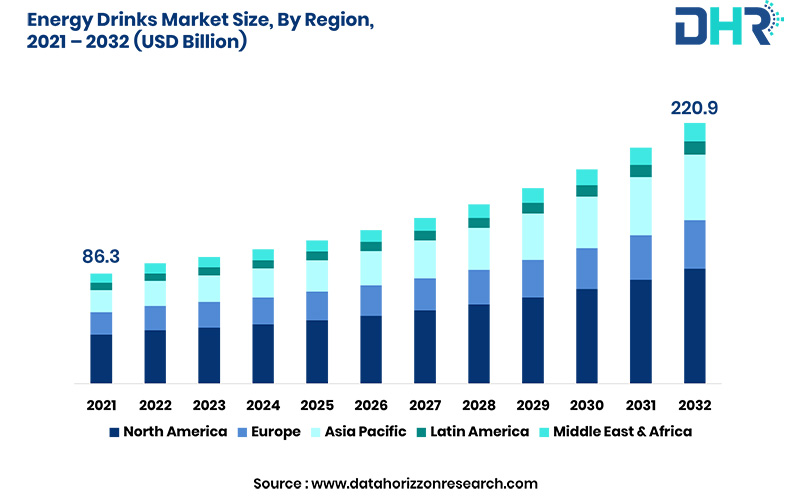Energy Drinks Market is anticipated to grow at a CAGR of 9.2 % from 2023 to 2032
According to DataHorizzon Research, the Energy Drinks Market was worth USD 92.3 billion in 2022 and is projected to hit USD 220.9 billion by 2032, boasting a Compound Annual Growth Rate (CAGR) of 9.2 %.

According to DataHorizzon Research, the Energy Drinks Market was worth USD 92.3 billion in 2022 and is projected to hit USD 220.9 billion by 2032, boasting a Compound Annual Growth Rate (CAGR) of 9.2 %.
The surge in demand for energy drinks stems from their perceived ability to enhance both physical and cognitive performance. Market participants are promoting beverages devoid of sugar, glucose, and high fructose corn syrups as functional drinks that not only heighten alertness but also offer physical benefits.
Energy drinks have gained significant popularity as a supplement among teenagers and young adults in the United States, with a predominant consumption by men aged between 18 and 34. This surge in popularity can be attributed to the rising awareness of health and wellness, coupled with the increasing prevalence of sports activities among the younger demographic.
Recently, market players in the US have shifted their focus from targeting athletes to catering to the preferences of young consumers, reflecting the growing demand for mental alertness among this demographic.
Energy Drinks Market Report highlights:
- The global energy drinks market growth is anticipated at a CAGR of 9.2% by 2032.
- PepsiCo, Inc. announced two new nutrition goals as part of their strategic transformation to reduce sodium and provide essential sources of nutrition in the foods consumers reach for.
- North America, particularly the US, has the highest per capita consumption worldwide. New product launches like ZOA cater to the increasing trend towards healthy organic diets.
In response to consumer preferences for healthier options, health-conscious brands are introducing a variety of sugar-free and calorie-free energy drinks. These products not only cater to the needs of athletes but also offer benefits for individuals who are overweight or obese. Additionally, sugar-free variants are particularly advantageous for those who are lactose intolerant.
Energy beverages, encompassing a wide range of options such as soft drinks, carbonated beverages, fruit and vegetable juices, beverage concentrates, ready-to-drink tea, and ready-to-drink coffee, are among the most commonly consumed beverages in the market. This diversity reflects the evolving preferences of consumers seeking convenient and functional beverages to support their active lifestyles.
Industry trends and insights:
- Energy drinks are high-caffeine beverages that claim to improve physical and mental performance. Their popularity has contributed to the growth of the energy drinks market.
- Monster Beverage Corporation acquired Bang Energy beverages and a production facility in Phoenix, Arizona, for approximately USD 362 million.
Energy drinks market segmentation:
- By Product: Drinks, Shots
- By Packaging: Cans, Bottles
- By Distribution Channel: On-trade, Off-trade
- By Region: North America, Latin America, Europe, Asia Pacific, the Middle East and Africa.
Regional analysis
North America held the largest market share, with the US having the highest per capita consumption worldwide. The US has experienced a shifting trend toward a healthy organic diet due to increased awareness about overconsumption of caffeine beverages. Several new product launches, such as ZOA infused with vitamins and antioxidants, sustain the image of healthy energy drinks in the market.
Competitive analysis
The competitive landscape of the industry is characterized by a high degree of fragmentation, with global brands holding the largest market share, leveraging their extensive experience in regional markets. Leading players in this space include Red Bull, Taisho Pharmaceutical Co Ltd., PepsiCo. Inc., Monster Beverage, Lucozade, The Coca-Cola Company, Amway, AriZona Beverages USA, Living Essentials LLC, Xyience Energy, and others.
These companies have established partnerships with numerous retail and chain food service outlets, allowing them to maintain a strong presence across various sales channels. Their sustained market presence is reinforced by continuous product innovation and unique marketing strategies, which set them apart in this fiercely competitive industry.









